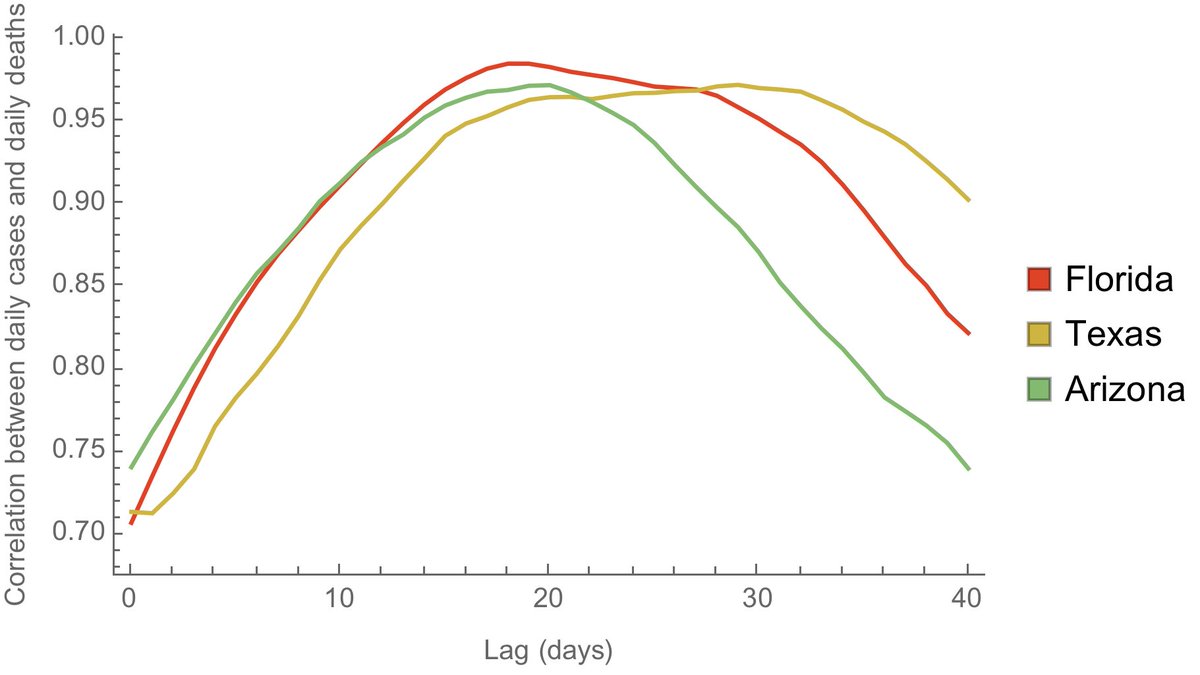A follow up to yesterday's controversial thread on societal behavior, population immunity and Rt to specifically address issue of what fraction of the population in Florida, Texas and Arizona may have had COVID-19. 1/16 https://twitter.com/trvrb/status/1291860659118804992
Multiple people expressed skepticism that 20% seroprevalence in Florida is reasonable. Others thought that 20% was patently impossible due to implied crude infection fatality ratio (IFR). 2/16 https://twitter.com/beta_rank_fb/status/1291956845574262785
This thread walks through a ballpark version of implied IFR that takes into account reporting delays in Florida, Texas and Arizona in their recent epidemic surge. Data and figures that follow from @COVID19Tracking. 3/16
If we look at Florida, we see cases start to increase ~June 6 and deaths start to increase ~July 3 (27 day lag). This fits expectation from disease progression alongside delays associated with reporting deaths. 4/16
We see a similar pattern in Texas, with cases starting to increase ~June 10 and deaths starting to increase ~July 6 (26 day lag). 5/16
Arizona also appears similar with cases starting to rise ~May 27 and deaths starting to rise ~June 23 (27 days). Additionally, cases appear to peak ~July 6, while deaths appear to peak 17 days later on ~July 23. 6/16
We can estimate the reporting lag between cases and deaths more rigorously by computing the lagged correlation between timeseries of daily cases and timeseries of daily deaths. 7/16
Across these three states, this lagged correlation is maximized at a 20 day reporting lag between cases and deaths. This 20 day reporting lag fits expectations from other sources ( https://www.cdc.gov/nchs/nvss/vsrr/covid19/). 8/16
We can ballpark a lag-adjusted IFR by comparing total deaths reported today to estimated infections 20 days ago, ie July 19. 9/16
Here, I assume a range of underreporting of catching between 1 infection in 4 as a case to 1 infection in 8. With 1 in 4, total infections are 4X total cases. With 1 in 8, total infections are 8X total cases. 10/16
For Florida, we have 8108 deaths reported as of Aug 8 and 350k cases reported as of July 19. This implies between 1.4M infections and 2.8M infections on July 19. This equates to a lag-adjusted IFR of between 0.3% and 0.6%. 11/16
For Texas, we have 8866 deaths reported as of Aug 8 and 325k cases reported as of July 19. This implies between 1.3M infections and 2.6M infections on July 19. This equates to a lag-adjusted IFR of between 0.3% and 0.7%. 12/16
For Arizona, we have 4140 deaths reported as of Aug 8 and 144k cases reported as of July 19. This implies between 576k infections and 1.15M infections on July 19. This equates to a lag-adjusted IFR of between 0.4% and 0.7%. 13/16
IFR of course depends on specific population infected, and I could believe there could be a slight improvement from early epidemic IFR of between 0.5% and 1% due to shift of disease burden towards younger individuals. 14/16
But overall, I take this as congruent with recent seroprevalance estimates suggesting a 5-6X ratio of cases to infections and IFR of still ~0.5% at this point. 15/16 https://twitter.com/trvrb/status/1286092963760582657
My best guess for fraction of Florida infected is about 12%, ie 525k cases ⨉ 5X ratio / 21.48M, though I could believe between 8% and 16% as reasonable. Lower than the 20% I threw out yesterday, but still high enough to impact epidemic spread if behavioral Rt is ~1.2. 16/16
Follow up #1: Some helpful further details to these estimates to consider from @youyanggu https://twitter.com/youyanggu/status/1292308008169549824

 Read on Twitter
Read on Twitter





